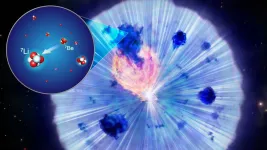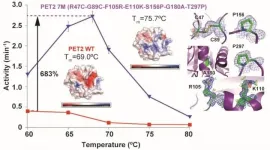(Press-News.org) QUT PhD researcher Zachariah Schuurs said the research team had identified a new binding site on the SARS-CoV-2 spike protein.
"Binding of the CoV-2 spike protein to heparan sulphate (HS) on cell surfaces is generally the first step in a cascade of interactions the virus needs to initiate an infection and enter the cell.
"Most research has focused on understanding how HS interacts on the receptor-binding domain (RBD) and furin cleavage site of the SARS-CoV-2 virus's spike protein, as these typically bind different types of drugs, vaccines and antibodies.
"We have identified a novel binding site on the N-terminal domain (NTD), a different area of the virus's spike that facilitates the binding of HS. This helps to better understand how the virus infects cells. The NTD is also a part of the spike protein that frequently mutates.
"Some antibodies in the blood that neutralise the viruses bind to the same region of the NTD.
"Therefore, targeting the NTD site with molecules like heparin (or heparin mimetics), a known anti-coagulant drug similar to HS, is a possible strategy to stop the virus binding to cells and infecting them."
Dr Neha Gandhi, from the QUT Centre for Genomics and Personalised Health, said COVID19 vaccines, although achieving success worldwide, were still far from being widely accessible.
"We need alternative antiviral strategies to prevent the spread of COVID-19 and treat infected people," Dr Gandhi said.
"Epidemiologists believe that persistent low-vaccine coverage in many countries will make it more likely for vaccine-resistant mutations to appear.
"Variants of concern have already emerged in South Africa, the US, India and Brazil. In this regard, alternate antiviral strategies are strongly needed to prevent the spread of COVID-19 and to treat people with COVID-19.
"Most SARS-CoV-2 variants have acquired a positively charged mutation in the spike protein. Molecules like heparin and its mimetics are negatively charged and therefore, these molecules could be used to treat people with severe effects of the virus and any emerging variants.
"Our research indicates that molecules that mimic the 3D structure of heparin with different sulphur chemistry, might be potential broad-spectrum antiviral drugs for COVID-19 and other emerging viral threats via direct interaction with the virus itself."
The multi-national study, "Evidence of a putative glycosaminoglycan binding site on the glycosylated SARS-CoV-2 spike protein N-terminal domain" published in the Computational and Structural Biotechnology Journal, used both computational and experimental techniques to confirm their finding.
The researchers used NCI Gadi and QUT Lyra supercomputers to model how HS and its inhibitor like heparin would interact with the spike protein.
Various researchers from the University of Queensland (Glycochemistry), Curtin University (Immunology), Zucero Pharmaceuticals and QUT conceptualised the study. These computational molecular simulations run by the QUT research team tested and confirmed the hypothesis that heparan sulphate could form a bridge between the newly identified binding site and another site on the spike important in the virus's infection.
INFORMATION:
Collaborators from the National Institute for Biological Standards and Control in the UK and the Istituto di Ricerche Chimiche e Biochimiche "G.Ronzoni" in Italy conducted bioinformatics to support the computational studies.
Collaborators at University of Liverpool and Keele University in the UK conducted laboratory experiments which confirmed the hypothesis.
A new study of lithium production in a classical nova found a production rate of only a couple of percent that seen in other examples. This shows that there is a large diversity within classical novae and implies that nova explosions alone cannot explain the amount of lithium seen in the current Universe. This is an important result for understanding both the explosion mechanism of classical novae and the overall chemical evolution of the Universe.
In the modern world, lithium is used in the rechargeable batteries powering smartphones and other devices. ...
Cheap to produce and long to degrade, plastic was once a manufacturing miracle. Now, plastic is an environmental plague, clogging landfills and choking waterways. A Japan-based research team has turned back to nature to develop an approach to degrading the stubborn substance. Similar to how a protein binds to cellulose in plants or to chitin in crustaceans to initiate decomposition, an engineered protein is on its way to binding to plastic particles in an effort to more efficiently break them down.
They published their results on June 29 in ACS Catalysis, a journal of the American Chemical Society.
"Polyethylene ...
In two recent articles published in Schizophrenia Bulletin, Sharon Hunter, PhD, an associate professor in the University of Colorado School of Medicine Department of Psychiatry, and M. Camille Hoffman, MD, MSc, an associate professor in the University of Colorado School of Medicine Department of Obstetrics and Gynecology, along with their research group, have uncovered a potential link between choline deficiency in Black pregnant women in the United States and increased risk of developmental and behavioral issues that can evolve into mental illness later in their children's lives.
The first article, published in November 2020, is a study, titled, "Black American Maternal Prenatal Choline, Offspring Gestational Age at Birth, and Developmental Predisposition to Mental Illness." The ...
Scientists at KAIST have fabricated a laser system that generates highly interactive quantum particles at room temperature. Their findings, published in the journal Nature Photonics, could lead to a single microcavity laser system that requires lower threshold energy as its energy loss increases.
The system, developed by KAIST physicist Yong-Hoon Cho and colleagues, involves shining light through a single hexagonal-shaped microcavity treated with a loss-modulated silicon nitride substrate. The system design leads to the generation of a polariton laser at room temperature, which is exciting because this usually requires cryogenic temperatures.
The researchers found another unique and counter-intuitive feature of this design. Normally, energy is lost during laser operation. ...
Australian scientists researching how our immune system responds to COVID-19 have revealed that those infected by early variants in 2020 produced sustained antibodies, however, these antibodies are not as effective against contemporary variants of the virus.
The research is one of the world's most comprehensive studies of the immune response against COVID-19 infection. It suggests vaccination is more effective than the body's natural immune response following infection and shows the need to invest in new vaccine designs to keep pace with emerging COVID variants.
Published today in PLOS ...
Polymer composite materials that combine magnetic and electrical properties are the subjects of particular attention for modern-day researchers. Their basic property is the ability to convert electric polarization into a magnetic field and vice versa. Although some materials exhibit a much better magnetoelectric effect, polymer-based composites are easier not only to produce but also to modify.
Such composites have great potential in a variety of different fields. For example, using them as a basis, scientists can develop surfaces that help cultivate various cells. In this case, polymer composites serve as a substrate through which it is possible to affect the culture using a non-contact and controlled electric charge and morphological properties ...
DANVILLE, Pa. - Having multiple chronic health conditions and living in a rural area were the top two factors affecting increased healthcare system contact among older patients with bladder cancer, a research team has found.
The Geisinger-led team evaluated 73,395 Medicare beneficiaries age 66 and older who had been diagnosed with non-muscle-invasive bladder cancer to assess their treatment burden, defined as the number of days the patients had contact with a health system in the year following diagnosis.
Nearly two-thirds of the patients had multiple co-existing chronic conditions at the time of bladder cancer diagnosis, as well as other aging-related conditions, including a history of falls, ...
Opioid prescribing preferences and practices among surgical residents and faculty differ, according to a new study published in the journal Surgery.
The study, titled "Evaluation of opioid prescribing preferences among surgical residents and faculty," was based on a survey of 56 residents and 57 faculty within the University of Colorado School of Medicine Department of Surgery. In the survey, participants were asked how many oxycodone tablets they would prescribe for 14 common surgical procedures.
Answers were compared between residents and faculty, as well as against the Opioid Prescribing Engagement Network (OPEN) guidelines and actual opioids ...
A new screening method that can test the effectiveness of therapeutic molecules designed to 'glue' proteins together in the body has been developed by researchers at the University of Birmingham and the University of Leicester.
The research paves the way for drug developers to screen large numbers of potential new drug compounds to discover new treatments for diseases such as breast cancer and Parkinson's disease.
The ways in which proteins interact with each other are fundamental to all cell functions. These interactions underpin every function of a healthy body, with any slight change in these interactions resulting in disease.
A handful ...
Scientists at the University of Cambridge have identified rare genetic variants - carried by one in 3,000 people - that have a larger impact on the risk of developing type 2 diabetes than any previously identified genetic effect.
Type 2 diabetes is thought to be driven in part by inherited genetic factors, but many of these genes are yet unknown. Previous large-scale studies have depended on efficient 'array genotyping' methods to measure genetic variations across the whole genome. This approach typically does a good job at capturing the common genetic differences between people, though individually these each confer only small increases in diabetes ...



